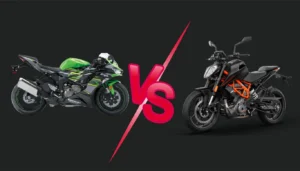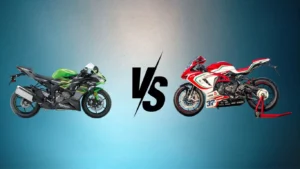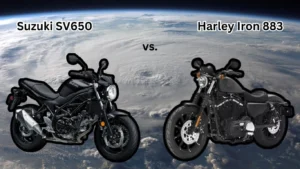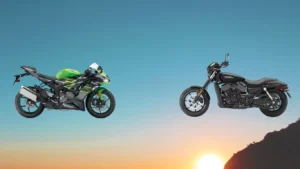Motorcyclists worldwide love two-stroke dirt bikes. Off-road enthusiasts like their simplicity, agility, and high power-to-weight ratio. Many riders wonder if their two-stroke dirt bikes can go faster. This detailed guide shows how.
Every crankshaft rotation completes a power cycle on a two-stroke dirt bike. Two-stroke bikes have high torque and punch, unlike four-strokes, which require two crankshaft revolutions per power cycle.
Basics of Two-Stroke Dirt Bike
Off-roaders like two-stroke dirt bikes for their light weight, high power-to-weight ratio, and simple design. Understanding the basics of a two-stroke dirt bike can improve its performance and longevity. Key points:
1. Two-Stroke Engine:
Engines power dirt bikes. Two piston strokes or one crankshaft revolution complete a power cycle in a two-stroke engine. Unlike a four-stroke engine, which requires four piston strokes or two crankshaft revolutions per power cycle.
2. Power Delivery:
Two-stroke engines deliver unique power. They produce a lot of power for their size. This power is usually delivered in a “power band,” the engine’s optimal RPM range. Two-stroke bikes are harder to control for novices but exhilarating for experts.
3. Maintenance:
Two-stroke engines are simpler and cheaper to maintain and repair than four-stroke engines. Due to high revs and gas-oil fuel, they wear out faster. Two-stroke dirt bikes need regular maintenance.
4. Fuel:
Two-stroke engines mix petrol and oil, unlike four-stroke engines, which have separate tanks. This mixture lubricates and fuels the engine. A wrong mix ratio can starve the engine of lubrication or make it run poorly.
5. Riding Technique:
Two-stroke dirt bikes are fun to ride, but their power band requires a specific technique. Staying in the power band requires high RPMs. Clutch and gear shifting skills are needed.
6. Environmental Impact:
Two-stroke engines are less efficient and polluting than four-stroke engines. They smoke because they burn oil and gas. Some areas have tightened two-stroke vehicle restrictions.
Two-stroke dirt bikes are thrilling to ride. Two-strokes offer high-speed off-road riding with their powerful engines, light frames, and simple mechanics. Two-stroke bike mastery requires skill, understanding, and regular maintenance.
Components of a Two-Stroke Dirt Bike
Optimizing and maintaining a two-stroke dirt bike requires knowledge of its basic components. Two-stroke dirt bike components:
1. Engine: The engine powers the bike. One crankshaft revolution completes a power cycle in a two-stroke engine. Cylinder, piston, spark plug, and crankcase are engine parts.
2. Carburetor: The carburetor blends air and fuel for combustion. It’s vital to engine performance and efficiency.
3. Air Filter: The air filter cleans air before the carburetor mixes it with fuel. Clean air filters improve engine performance and longevity.
4. Exhaust System: The combustion chamber exhausts burned gases. Powerstrokes require an efficient exhaust system.
5. Transmission: Transmissions transfer engine power to wheels. Clutch, gearbox, and chain drive.
6. Suspension: The bike’s handling and stability depend on the suspension system’s shock absorption and wheel contact.
7. Tires: Tires enable acceleration, braking, and cornering. Design and condition affect bike performance.
8. Brakes: Brakes are essential for speed control and safety. Two-stroke dirt bikes typically have disc brakes on both wheels.
9. Frame: Bikes have frames. It supports all components and strengthens, stabilises, and weighs the bike.
10. Fuel Tank: The fuel tank holds engine fuel. It determines the bike’s range.
Two-stroke dirt bikes have these main parts. Understanding these parts will help you optimise your bike’s performance.
How Does A Two-Stroke Engine Works
Two-stroke engines, found in dirt bikes, chainsaws, and lawnmowers, work efficiently. Two-stroke engines complete their power cycle in two piston strokes or one crankshaft revolution.
The piston draws fuel and air into the crankcase to start the cycle. The combustion chamber above the piston compresses the fuel-air mixture drawn earlier. This compressed mixture explodes when the spark plug ignites it, forcing the piston down. This powers the crankshaft and bike.
The piston compresses the new crankcase fuel-air mixture as it descends. When the piston hits bottom, it opens the exhaust port, releasing burned gases. The compressed fuel-air mixture in the crankcase is forced into the combustion chamber above the piston for the next cycle. Thus, the two-stroke engine’s power cycle is completed in two piston movements: up (intake and compression) and down (expansion) (combustion and exhaust).
Key Components of a Two-Stroke Engine
In one crankshaft revolution, a two-stroke engine completes a power cycle with two piston strokes. Dirt bikes, lawnmowers, and jet skis use two-stroke engines due to their efficiency. Two-stroke engine parts:
1. Cylinder: Pistons move in the cylinder. It houses the piston-driving air-fuel mixture combustion.
2. Piston: The piston moves inside the cylinder. The piston draws in, compresses, and expels exhaust gases after combustion.
3. Spark Plug: The piston descends and generates power when the spark plug ignites the compressed air-fuel mixture inside the cylinder.
4. Crankshaft: The crankshaft converts piston linear motion into rotational motion, which drives a wheel or propeller.
5. Exhaust Port: The exhaust port lets combustion exhaust out of the cylinder.
6. Transfer Port: Fresh air-fuel mixture from the crankcase enters the cylinder through the intake port, or transfer port.
7. Crankcase:
Crankcases house crankshafts. In a two-stroke engine, the piston’s downward movement creates a pressure difference that draws air-fuel mixture into the crankcase and into the cylinder.
Understanding these key components is essential for troubleshooting and maintaining a two-stroke engine. This knowledge helps you choose engine care and performance upgrades.
Factors Influencing a Dirt Bike’s Speed
To maximise your two-stroke dirt bike’s speed, you must understand its performance factors. Horsepower doesn’t determine speed. It’s complex and dependent on your bike’s design, maintenance, and operating conditions. Let’s examine the bike’s weight, engine efficiency, aerodynamics, and traction.
Weight Considerations
Lighter objects move with less force in physics. Dirt bikes’ speed depends on their power-to-weight ratio. Power-to-weight ratio compares horsepower to bike weight (in kilograms). Your bike can go faster if your engine has a high power-to-weight ratio.
Replacing heavy parts with lighter ones or removing unnecessary parts can reduce weight. While reducing weight can boost speed, it shouldn’t compromise the bike’s balance, stability, or safety. For instance, using too many lightweight structural components may weaken the bike.
Fuel Economy
Engine efficiency also affects dirt bike speed. Engine efficiency measures how well the engine turns fuel into mechanical power. A powerful engine increases speed.
Spark plugs, carburetor cleanliness and tuning, air-fuel mixture quality, and exhaust system condition affect engine efficiency. Regular maintenance and tuning can boost engine efficiency. This includes carburetor cleaning, spark plug replacement, and exhaust system inspection.
Traction and Aerodynamics
Aerodynamics and dirt bike design affect speed. Aerodynamics studies airflow around objects. Good aerodynamics allow a bike to move faster. Streamlining the bike’s design and removing air-resistive protrusions improves aerodynamics.
Traction also impacts speed and it is your bike’s ground grip. Traction is essential for converting engine power into forward movement. If your bike’s tyres have poor traction, the engine’s power will spin the wheels instead of moving the bike. Selecting and maintaining the right tyres for your terrain can boost your bike’s speed.
Many factors affect dirt bike speed. Understanding these factors helps riders modify and maintain their bikes for maximum performance. Each strategy—weight loss, engine tuning, aerodynamics, and traction—brings you closer to faster two-stroke dirt bike speeds.
How To Make A Two-Stroke Dirt Bike Faster
Performance modifications, weight reduction, and maintenance can boost two-stroke dirt bike speed. Make your two-stroke dirt bike faster:
1. Performance Exhaust System:A performance exhaust system can boost your dirt bike’s speed and power. These exhaust systems allow exhaust gases to exit the combustion chamber faster and more efficiently, ensuring the fastest power stroke.
2. Air Intake System Upgrade: More air in combustion increases stroke strength and speed. Installing a performance air filter can increase combustion air, which boosts stroke and speed.
3. Carburetor Improvement: A carburetor that mixes air and fuel perfectly can boost engine performance. Get a performance carburetor or have it tuned.
4. High-Performance Spark Plugs: High-performance spark plugs improve fuel-air mixture ignition, resulting in more powerful combustion and a faster power stroke.
5. Weight Reduction: Lighter bikes are faster and agile. Replace heavy bike parts with lighter ones if it doesn’t compromise structural integrity or safety.
6. Optimize Gear Ratios: Bike gear ratios can boost acceleration and top speed. Lower gear ratios increase top speed, while higher ones accelerate. Gearing too high can reduce low-end power, while gearing too low can limit top speed.
7. Suspension and Tire Upgrades: Suspension upgrades improve high-speed stability, handling, and performance. Good-quality tyres with traction improve acceleration, speed, and handling.
8. Regular Maintenance: Speed depends on regular maintenance. To maintain optimal performance, the engine, carburetor, and other components are checked and adjusted.
Targeted upgrades, weight reduction, and meticulous maintenance make two-stroke dirt bikes faster. These changes and regular bike evaluations can boost speed and performance. However, speed increases responsibility. Prioritize safety in bike maintenance and riding.
Conclusion
It’s fun to speed up your two-stroke dirt bike, but safety comes first. Wear protective gear and don’t compromise your bike’s handling and stability. Enjoy the ride, but respect your bike’s power and your surroundings.





